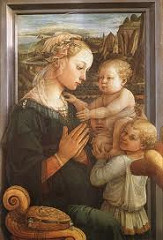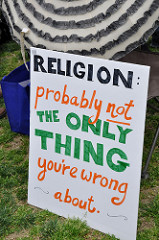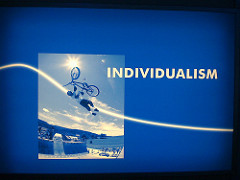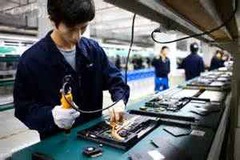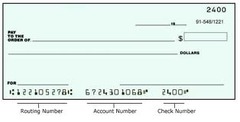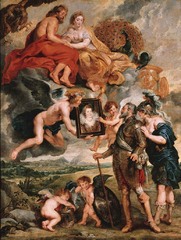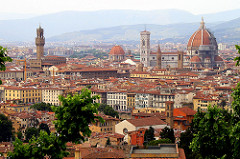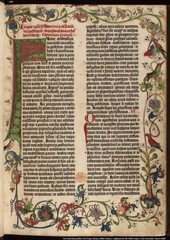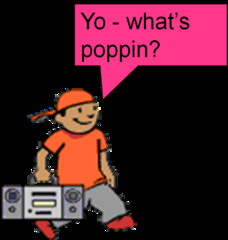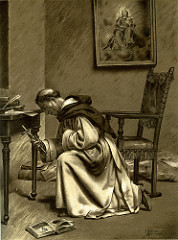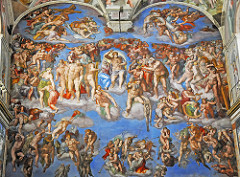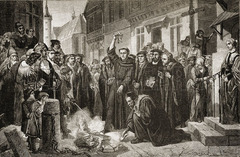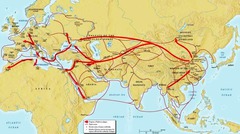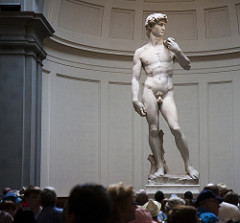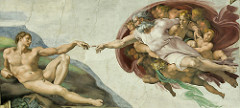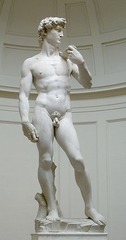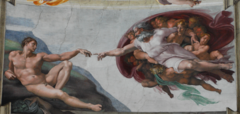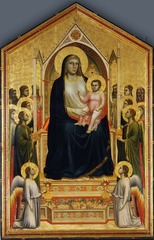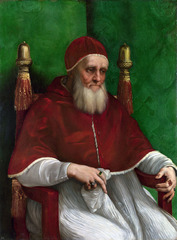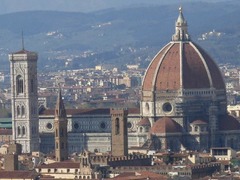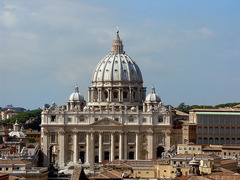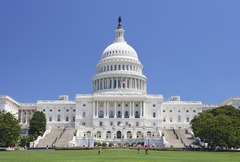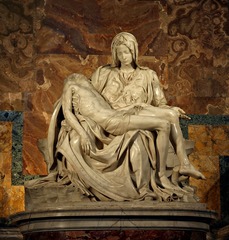Zero Sum Game
An important concept from feudalism. Either I have it or you do. Bottom line: one of us is left with zero. Nasty game. Because you harvest only a fixed amount of land, the only way to to make more money is to take over someone else’s. This leads to economic insecurity as people are afraid to travel for fear of theft, invasion, and war. You’re taking money not making it, promotes a society based on thievery. Medici’s banking system will slowly start to change society from it.
Characteristics of Pre renaissance Art-
Darker colors=darker period. Less colorful=less happy. Stiffer bodies=no accurate display of anatomy. No muscles shown=no celebration of the human experience now here on Earth. 2D= 2 sides to life (right and wrong; life and death; heaven and hell).
Define and give role of Black Death in helping to end feudalism and cause the renaissance
It infected people in bustling commercial centers (think of Florence, Rome, London, Paris, etc.). Overnight it wiped out one generation of skilled craftsman, artists, and tradesman, nobility, and clergy. This required the quick building of schools to educate a new class of workers and clergy. Also, the devastation sowed the seeds of doubt as the corruption of the Catholic Church could not answer the spiritual questions of the millions who were dying from the plague. In three years 1/3 of Europe died. In a way, it wiped Europe’s slate clean so that it could rebuild itself. Europe needs to reboot.
Characteristics of Renaissance Art
Lighter colors=better period. More colorful=happy & bright. More flexible bodies=more accurate portrayal of anatomy. Bodies look more natural = celebration of life here and now. 3D=3 sides to a problem: right, wrong, and I don’t know, let’s find out. Think about the School of Athens. It celebrates the process of learning by conversation. It celebrates famous thinkers from the past, females, males, Muslims, Christians, Greeks, and Romans. There’s no right answer, just glorification of learning for its own sake.
Renaissance
Re-nascent. A re-birth. A time of renewed enthusiasm for life here and now (not the afterlife), of learning, and of achieving human potential. Humanism, Individualism, Secularism inspired the rebirth. It was fueled by a revolution in finance, thanks to the Medici’s and trade with the Muslims that began with The Crusades.
Humanism
Thinking outside the box. The study of ancient and GREEK AND ROMAN texts, not just the New Testament. This led to a drive to learn new things. Think of humanism as when Elvis first appeared on TV, The Ed Sullivan Show, 1956. It lit up America’s youth. Kids started to form bands, make music, and they still do. Same with ancient Greek and Roman texts. It was fresh air to a population who had only church teachings, stifling them for 1,000 years. Fresh ideas of living, learning, and growing in the present moment percolated, thanks to Greek and Roman inspiration. Prior to the Renaissance there was Aristotle and The Bible. Now, the realization began to unfurl. There were other sources of knowledge. Thank you, Greek and Roman thinkers, the ruins of which populated cities across Europe. And thank you, Muslim Empire, who brought that knowledge to Europe
Secularism
Being outside the box. The study of non-religious subject matter. It’s a big deal. For a thousand years after the fall of the Roman Empire, the Catholic Church dictated what people could think. Now people were experimenting with thoughts that went beyond the church, thanks to humanism. But you had to be careful, you could still get excommunicated. Example: Galileo. He was excommunicated for saying that the Earth revolved around the Sun, which went against the church and Aristotle.
Individualism
Pursuing fame instead of heaven, the new immortality. The means: Distinguish yourself from others by demonstrating your excellence, you genius, and you will become immortal like Michelangelo. It’s a great departure from the feudal past of immortality via heaven after death. Now people create master works like Michelangelo’s David or Raphael’s School of Athens . The lust for fame, individualism helped motivate the great works of the age, as it does today. Think of Michelangelo as the first Michael Jackson.
Define and give role of Crusades
They were military expeditions made by Christians in France, Spain, Italy and England to Palestine in the 1100’s and 1200’s. The goal was to reclaim Jerusalem from the Muslims. Christians viewed the Muslims as inferior but were embarrassingly wrong. At their height, the Muslim Empire was the most educated civilization in the world. They mastered ancient Greek and Roman, which they gave to Europeans. These sources inspired The Renaissance. The Muslim Empire also boasted the world’s most advanced mathematics. It made modern navigation, map making, and engineering possible, which culminated in Columbus’s voyages. It was Muslim technology that helped Europe break out of feudalism. The Crusades restarted the trading relationship between Western Europe and the Middle East.
Explain how the United States is like the Muslim Empire
As the Muslim Empire traded their technology to the Europeans which contributed to rise of Western Europe, the United States has traded much of its technology to China, as China now manufactures our computers, iPhones, and most of our gadgets. One difference between the Muslim Empire and the USA is that the Muslim Empire thrived for over 600 years. The United States has been around for a bit over 200 years.
How does modern banking come about
The Medicis exchanged gold for promissory notes (on paper). The gold was kept in a vault. Safe. With the promissory notes, customers could go to any Medici banking branch around Europe to withdraw the gold. Think of the Medici’s as inventing checkbooks. Just because someone has your checkbook doesn’t mean they have your money. Only if they have your signature. The advantage: if the ship sinks, you don’t lose the gold. The disadvantage: your money is only as good as the promise. The Medici’s kept the gold safe.
Medici
One of (if not THE) most powerful families in Italy. they were wealthy bankers, basically bringing paper money to Europe. They patronized artists, hired Michelangelo, Raphael, and Leonardo Da Vinci. This pattern of expressing wealth through art contributed to the Renaissance as artists redefined beauty. Also the Medici’s hired scientists, architects, artists, engineers, and writers to broaden their knowledge, which enriched the world.
Perspective
A popular technique in which a three dimensional piece of art is displayed on a flat surface. It is one of the characteristics of Renaissance Art.
Leonardo da Vinci
A talented Renaissance man who was a scientist, inventor, sculptor, and a painter. He painted one of the best-known paintings of the renaissance, The Last Supper and Mona Lisa. The Last Supper is a renaissance masterpiece as everyone in the painting looks different, has lifelike poses and expressions, and the background has geometric three dimensionality.
Renaissance Man
A master of many arts/tasks. Two examples:
Leonardo Da Vinci and Michelangelo. Leonardo Da Vinci was a great inventor, artists, musician, and architect. The picture shows Leonardo trying to apply math to the human form, showing that in symmetry is beauty. And of course, Michelangelo, a great painter, sculptor, poet, and architect.
Why Rome did not thrive as Florence did
Because the Popes would not allow their banks to loan money with interest, so, no banking industry could thrive there. The irony is that the Popes and the Catholic Church got corrupt from the tithe from which they bought art and lived “Worldly Lives.” The opulence in Rome will outrage Martin Luther, who will begin a religious revolution, thanks to the printing press. Get the irony: the Pope can’t loan money at interest but they abuse the tithe system.
Guttenberg Bible
One of the most important books in world history, as it was the first printed Bible, meaning it was mass produced for people to read. Slowly (because it will take generations for literacy to become the norm), people will read the Bible for themselves and thereby start to think for themselves. Perhaps the Gutenberg Bible is more important than Luther’s German translation of the Bible, as it was the Gutenberg Bible that initially inspired Luther.
Vernacular
The language of the people, for example, Germans speaking German, English people speaking English. Big deal. During feudalism, church books were written in Latin, a language few could read. With the Renaissance, modern languages will be formalized. Shakespeare will formalize the English language, same with Luther for German (translates the Bible into German), Dante for Italian, Cervantes for Spanish.
Why did Florence get rich?
4 answers: 1) The Medicis got rich on the wool trade, 2) they set up banks based on paper money, 3) they patronized great artists and thinkers that created the Renaissance, 4) they created a culture for learning. When Rome refused to build banks, they gave Florence the opportunity to thrive.
An irony of the power of the Medicis
While they were the most powerful family in Italy, they gave artists the power to decide what is beautiful. This allowed artists to be inspired by the Greeks and the Romans (humanism) and depart from strict church teachings (secularism). Also, artists could now put their names on paintings and this allowed them to (pardon the pun) make a name for themselves. The artists became celebrities, the first rock stars, really. Their view of beauty is still very much with us.
2d
It was one of the characteristics of pre-renaissance art, largely because the geometry of the time was lacking without the number zero (thank you Muslim Empire). It can be also thought of as a 2D world of feudalism. Right and wrong. Life was black and white, serf or noble, heaven or hell. Bottomline: you stayed inside the box.
3D
It is one one the characteristics of Renaissance art, an improved aspect of depth perception in a painting. This was made possible by improved mathematics thanks to the number zero from the Muslim Empire. But perhaps it meant more than just improved depth perception (a vanishing point) in the painting. It also meant people could think in more nuanced ways, more colorfully, as they were inspired by the new values of humanism, secularism, and individualism. Bottomline: people try to break outside the box, always at the peril of excommunication.
Why it was important that artists could put their names on their art
Because previously no artist could. Prior to the Renaissance, the purpose of all art was to glorify the church only. That anyone or anything could be glorified other than the church was considered sinful. Once artists could sign their name to their work, they began to transform how people viewed the world and redefined beauty, as artists competed to be the best.
Michelangelo
Arguably the greatest artist of all time. His La Pieta, Sistine Chapel, and The David are quintessential examples of Renaissance art. He was called “The Divine Michelangelo” while alive, a great example of individualism. Although he was frequently commissioned by the church, he learned his skills by doing autopsies, which violated the canon law. His homosexuality probably further contributed to his fears of damnation. In the attached picture, he is portrayed as a flayed skin in the Last Judgement, saved from damnation by St. Bartholomew, who holds his skin/hell from slipping into fiery hell.
Fundamentalist
Someone who wants society go back to when things were more pure. For example, Savonarola wanted Florence to go back to feudalism and its religiosity. He thought that humanism, secularism, and individualism were bad things. (And feudalism was good?) Think of ISIS as extreme fundamentalism, as they try to make an Islamic state as (they imagine) it would have existed in 900 A.D.
Savonarola
Michelangelo’s preacher. He said that Florence’s Renaissance and wealth would cause Flortentinians to burn in hell. He wanted Florence to revert back to the religiosity of Feudalism. He traumatized Michelangelo. Ultimately, he scared the Catholic Church too as they excommunicated him, burnt him to a stake. This preacher’s ideas foreshadowed the Protestant Reformation. Luther and Michelangelo both borrow form Savonarola.
The Last Judgement
Michelangelo’s famous painting on the wall adjacent to the Sistine Chapel. It reveals his conflict with secularism, humanism, and individualism. It shows Michelangelo’s fear of damnation (see how he is portrayed as a flayed skin) as a muscular/humanistic christ and St Bartholomew (as if a Greek God) save him from burning in hell. He is featured in the painting–yes, that shows his sense of greatness (how different from Raphael in the School of Athens)–but Michelangelo looks doomed. Get the irony and turmoil shown in the painting. It speaks to the transition and turmoil of the Renaissance, from feudalism to modernity. It takes a toll on those who dared step outside the feudal box.
Martin Luther
He protested against the church and because he used the printing press. He started a religious revolution in Europe that continues to this day. Big idea: Luther protested against the extravagance of the church. He survived because of the printing press. It was the reality check the church didn’t expect.
How many Europeans were directly impacted by the Renaissance?
Approximately 3%. Most serfs could not leave their land and most people were serfs, farmers. However, merchants (as a growing middle class was beginning to emerge during the Renaissance) were beginning to see the art, read the new literature, and hear the exciting conversations of secularism, individualism, and humanism.
350 BCE
Ancient Athens creates a democracy. Aristotle creates/teaches his philosophy. It will later be embraced by the Roman Empire and Roman Catholic Church.
401
Rome falls. Feudalism takes over. No central authority or common law. The Catholic Church becomes the strongest institution in Europe as they collect their tithe unimpeded until Luther.
900
Height of the Muslim Empire, spanning from India to Spain.
1100’s-1200’s
The Crusades. The Muslims and Europeans begin to trade, as Europe gets the technology to start to break out of feudalism.
1347-1350
Black Death takes place throughout Asia, North Africa, and Europe. It happens in Europe because of the trade between Muslims and Europeans. (The plague started in China.) The Plague kills 1/3 of Europe’s population in three years. Eventually, it gave rise to new jobs and workers who demanded higher pay–because so many skilled workers died. It created the economic and intellectual conditions that lead to the Renaissance. Europe needs to reboot.
1455
The year that Johan Gutenburg created the printing press which printed books efficiently. Fast and more accurate than copying by hand. This led to the Renaissance. People s.t.a.r.t. (long road for most people to become literate, takes hundreds of years) to think for themselves. Reading means thinking. Gutenberg prints the Bible and ancient texts and maps from the Muslims.
1492
The year Christopher Columbus reached America. He called the people living on it Indians because he believed he reached in India. His discovery enriched the Medici’s of Florence, Italy. The Medicis would eventually hire Michelangelo and made him into a great artist. This year helps the renaissance takes off. Dr. Coleman rhyme: In 1492 Spain kicks out the Muslim and the Jews, steals their money so Columbus could sail the ocean blue; the Muslim Empire is through.
1512
Michelangelo paints the Sistine Chapel. In it are revolutionary ideas that spur the Protestant Reformation. This is because of church excesses/abuses, spending so much to impress as opposed to helping the needy and saving souls.
1517
Martin Luther posts the 95 Theses to protest church corruption.
Irony of The David
We know that this biblical character was small especially in comparison to Goliath, whom he killed at the age 15. Goliath stood at 9 feet tall and David at 5’3″. But Michelangelo made him into a symbol of physical beauty and far taller than Goliath, saying that it David’s intelligence made him strong and powerful. It’s what makes us human. Basically, Michelangelo “exteriorized” David’s inner strengths. The statue would become the symbol of Florence and perhaps even the Renaissance itself. Maybe it represents an ideal of manhood still celebrated: smart, muscular, balanced, not violent by impulse.
Irony of The School of Athens
A perfectly secular painting in the Vatican. In the painting it glorifies Greek, Roman, Muslim, and Renaissance scholars like Michelangelo and Leonard Da Vinci. Jesus is not pictured but there are symbols of Greek and Roman gods. The painting’s display of secularism and humanism in the Vatican moved Martin Luther to protest.
Ironies of Creation
In the very heart of the Vatican, God is shown on the side of the painting not the center as was customary for a thousand years prior, e.g. Giotto’s Madonna and Child. In Michelangelo’s Creation, God actively seeks out Adam, as if humankind has a power all its own. Luther will not be pleased with this secular departure.
The David – 1504
Answer these questions:
1. Who is the artist?
2. List three qualities that make this a renaissance masterpiece.
3. Explain: how is humanism, secularism, and/or individualism revealed in this work of art?
The David – 1440
Answer these questions:
1. Who is the artist?
2. Explain why this statue of David does not reveal the renaissance values (humanism, secularism, or individualism) as much as Michelangelo’s David?
Creation
Answer these questions:
1. Who is the artist?
2. List three qualities that make this a renaissance masterpiece.
3. Explain: how is humanism, secularism, and/or individualism revealed in this work of art?
Madonna and Child 1513-14
Answer these questions:
1. Who is the artist?
2. List three qualities that make this a renaissance masterpiece.
3. Explain: how is humanism, secularism, and/or individualism revealed in this work of art?
Madonna and Child – 1305
Answer these questions:
1. Who is the artist?
2. List three qualities that make this a PRE-renaissance masterpiece.
3. Explain: how is humanism, secularism, and/or individualism NOT revealed in this work of art?
School of Athens 1510
Answer these questions:
1. Who is the artist?
2. List three qualities that make this a renaissance masterpiece.
3. Explain: how is humanism, secularism, and/or individualism revealed in this work of art?
Pope Julius II (painting by Raphael)
Pope Julius II hired Michelangelo and did not pay him for over a year. He beat Michelangelo to force him to continue working. It did not work as his father’s beatings did not discourage Michelangelo from being an artist when he was a child. Michelangelo refused to work until paid. Big idea: Pope Julius II only bowed to one man, Michelangelo. Michelangelo kept his dignity throughout the ordeal.
El Duomo
Who built it? Who was inspired by it? How is it relevant to us?
The architect, artists, inventor, and engineer–a Renaissance Man!–who built El Duomo in 1436, which inspired Michelangelo’s building of the Basilica, which would eventually inspire the building of our capital building. Thank you, Brunelleschi.
Basilica
Who drew the masterplan? What is its relevance to us?
The plan for this dome was devised by Michelangelo. He found his inspiration from Brunelleschi’s dome which was much larger than Michelangelo’s. This dome would inspire the dome which sits on top of the US capital in Washington D.C. As the renaissance started in Italy, it continues in the USA
US Capital Building
Who inspired it? Describe its renaissance origins.
It is inspired by Michelangelo and Brunelleschi’s domes. This suggests that the values of the Renaissance (humanism, secularism, and individualism) are still with us today. More than that, those values are celebrated.
La Pieta
Answer these questions:
1. Who is the artist?
2. List three qualities that make this a renaissance masterpiece.
3. Explain: how is humanism, secularism, and/or individualism revealed in this work of art?
Michelangelo’s first masterpiece. So lifelike that people thought it moved. In response to someone else who claimed to have made the statue, Michelangelo chiseled his name on Mary’s gown to the horror of all to witness. (He would never do that again.) Big idea: Michelangelo took individualism to extreme levels; perhaps, it was his only salvation.



